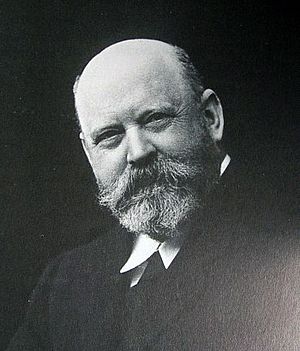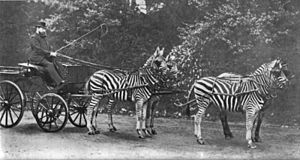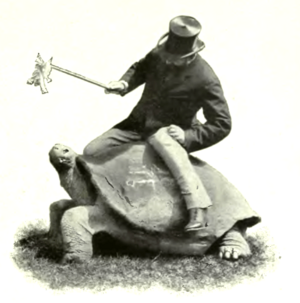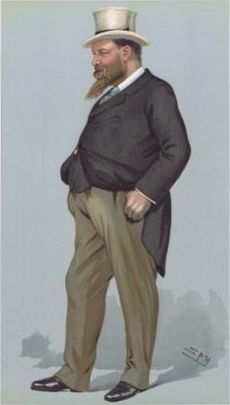Walter Rothschild, 2nd Baron Rothschild facts for kids
Quick facts for kids
The Lord Rothschild
|
|
|---|---|
 |
|
| Member of Parliament for Aylesbury |
|
| In office 6 January 1899 – 10 January 1910 |
|
| Preceded by | Ferdinand James von Rothschild |
| Succeeded by | Lionel Nathan de Rothschild |
| Personal details | |
| Born |
Lionel Walter Rothschild
8 February 1868 London, England |
| Died | 27 August 1937 (aged 69) Tring, Hertfordshire, England |
| Political party | Liberal Unionist Conservative (after 1912) |
| Relatives | Rothschild Family |
| Occupation |
|
| Military service | |
| Allegiance | |
| Branch/service | Territorial Army |
| Rank | Major |
Lionel Walter Rothschild (born February 8, 1868 – died August 27, 1937) was a fascinating British man. He was a banker, a politician, and a soldier, but he was most famous for being a passionate zoologist. He loved animals and collected a huge number of specimens. Walter was also part of the famous Rothschild family, known for their banking business. He played an important role in history when he received the Balfour Declaration, a letter from the British government that supported creating a home for Jewish people in Palestine.
Contents
Early Life and Passions
Walter Rothschild was born in London. He was the oldest son of Nathan Rothschild, a very rich banker and the first Jewish person to become a noble in England. Walter was not very strong as a child, so he was taught at home. He later studied at the University of Bonn and Magdalene College, Cambridge.
From a young age, Walter loved animals. When he was only seven, he decided he would open a zoological museum! As a child, he collected insects, butterflies, and other creatures. He even had unusual pets like kangaroos and exotic birds at his family home in Tring Park.
When he was 21, Walter had to start working at his family's bank in London. He worked there for many years, but he wasn't really interested in banking. Luckily, his parents understood his passion. In 1908, when he was 40, they let him leave the bank. To support his dream, his parents helped him open a zoological museum and paid for trips all over the world to find new animals.
Walter was a tall man, about 6 feet 3 inches (1.9 meters). He was also quite shy and had a slight speech problem. But he was also very adventurous! He once had his picture taken riding on a giant tortoise. He even drove a carriage pulled by four zebras to Buckingham Palace to show everyone that zebras could be trained!
Amazing Zoological Career


Walter Rothschild studied zoology at Cambridge University. He became very interested in taxonomy, which is how scientists classify and name different animals.
Even though Walter traveled and collected animals in Europe and North Africa, his health and work meant he couldn't go everywhere. So, he hired explorers and collectors to find animals for him in faraway places. He also hired scientists to help him study and organize his huge collections.
Walter's collection was truly massive! It included:
- 300,000 bird skins
- 200,000 birds' eggs
- 2,250,000 butterflies
- 30,000 beetles
- Thousands of mammals, reptiles, and fish specimens
This was the largest animal collection ever gathered by one person!
Many animals were named after him, like the Rothschild giraffe (Giraffa camelopardalis rothschildi). This giraffe is special because it has five ossicones (horn-like bumps) instead of the usual two. More than 200 other animals, including insects, birds, mammals, and spiders, also carry his name.
Walter opened his private museum in 1892. It was open to the public and housed one of the biggest natural history collections in the world. Sadly, in 1932, he had to sell most of his bird collection to the American Museum of Natural History.
In 1933, Walter helped start the British Trust for Ornithology (BTO), an organization that studies birds in the British Isles.
When Walter died in 1937, he left his entire museum and all its contents to the British Museum. This was the biggest gift the museum had ever received! Today, the Walter Rothschild Zoological Museum at Tring is part of the Natural History Museum, London.
After a trip to Hungary in 1902, Walter brought six live edible dormice (Glis glis) back to Tring. Some of them escaped and started living in the wild. Now, there are at least 10,000 of them in an area of about 200 square miles! Even though they are considered an invasive species, they are protected by law.
Walter received an honorary doctorate degree in 1898. He was also chosen to be a Trustee of the British Museum in 1899 and became a Fellow of the Royal Society in 1911.
Political Career
Walter Rothschild was a Member of Parliament for Aylesbury. He was part of the Liberal Unionist Party and served from 1899 until he left politics in 1910.
Military Service
Even though he wasn't very strong, Walter served as an officer in a part-time army unit called the Royal Buckinghamshire Yeomanry. He became a captain in 1902 and was promoted to major in 1903 before retiring in 1909.
Zionism and the Balfour Declaration
Walter Rothschild was an active Zionist, which means he supported the idea of a Jewish homeland. He was a close friend of Chaim Weizmann, a leader in the Zionist movement. Together, they worked to create a statement supporting a Jewish home in Palestine.
On November 2, 1917, Walter received a very important letter from the British foreign secretary, Arthur Balfour. This letter, known as the Balfour Declaration, stated that the British government supported the idea of "a national home for the Jewish people" in Palestine. This was a huge moment for the Zionist movement.
His Legacy
Walter inherited the title "Baron Rothschild" from his father in 1915. He passed away in 1937 at his home in Tring Park, Hertfordshire, when he was 69 years old. He was buried in Willesden Jewish Cemetery in London. Since he didn't have any children who could inherit his title, it passed to his nephew, Victor Rothschild.
Walter also held the title "Baron de Rothschild" from the Austrian nobility. This title was officially recognized in the United Kingdom in 1932.
See also
- Extinct Birds
- History of the Jews in England
- Rothschild banking family of England
- Waddesdon Manor



